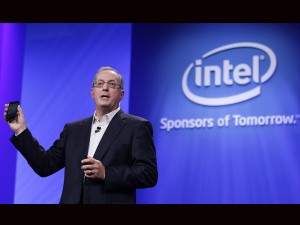Google, Intel engage in tag-team tech play

INTEL INNOVATIONS Intel CEO Paul Otellini, holds up a Google Android phone running on an Intel chip during the keynote address at the Intel Developer Forum in San Francisco, Tuesday, Sept. 13, 2011. AP Photo/Paul Sakuma
SAN FRANCISCO—A Windows PC desktop powered by a solar cell the size of a postage stamp, several devices that share display contents such as video, photo and notifications seamlessly, a communication tablet that may replace your traditional phone in the office, and Google’s Android OS finally getting into Intel’s space—these are what’s in store for consumers, Intel said during the Intel Developer Forum here.
Over the past several years, Intel has been expanding into the mobile devices space, which is growing more rapidly than personal computers.
Intel’s partnership with Google, whose Android is now the most widely used mobile operating system, is expected to accelerate the Santa Clara-based chipmaker’s stalled presence in the smartphone and tablet space.
Intel president and CEO Paul Otellini said smartphones powered by Intel’s Atom chips and running on Android OS would be available in the first half of next year.
The two tech titans will work together to optimize future versions of Android for Intel’s family of low-power Atom processors. This means that future versions of the Android platform will support Intel technology, in addition to other architectures.
“Combining Android with Intel’s low power smartphone roadmap opens up more opportunity for innovation and choice,” said Andy Rubin, senior vice president at Mobile at Google. “This collaboration will drive the Android ecosystem forward.”
According to Otellini, “by optimizing the Android platform for Intel architecture, we bring a powerful new capability to the market that will accelerate more industry adoption and choice.”
Intel’s demo of a desktop powered by a postage-sized solar cell reaffirms the company’s effort to reduce not only the size of microprocessors but also its power consumption.
Intel’s processor roadmap has now gone into the 22 nm microarchitecture technology with the introduction of thin notebooks called “Ultrabooks.”
The devices are ultrathin powerful notebooks capable of all-day computing with a single battery charge. The Ultrabook also offers 10 days of connected standby battery life.
The device is powered by Intel’s next-generation microprocessor called “Haswell” and it will hit the shelves next year.
Otellini said the Haswell project is a result of the company’s obsession with power reduction.
He predicted the microprocessor platform power innovation will reach levels that are difficult to imagine today.